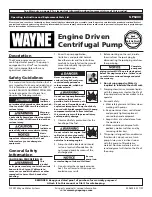
5
PUMP PLACEMENT
Risk of injury or property damage from fire.
• The pump must be at least 5 feet from structures having combustible walls and/or other combustible materials such as leaves, grass, and
brush.
• Reflective exhaust heat may damage the fuel tank, causing fire. Keep at least 3 feet of clearance on all sides of the pump for adequate
cooling, maintenance, and servicing.
1. Locate the pump outdoors in a well-ventilated place on a flat, level surface.
2. Place pump on a rigid, level foundation to prevent the pump from tipping, rolling, sliding or creeping while operating. If the pump is not
stable, the weight of liquid-filled hoses could cause the unit to tip over.
3. Use a non-collapsible hose on the suction side of the pump and keep the suction hose as short as possible. A collapsed, kinked, obstructed or
long suction hose will reduce priming and pumping performance, and may contribute to loss of prime which can cause pump overheating.
4. Use a suction hose the same size as the suction port on the pump. If the suction hose is long, increase it by one size to improve flow.
5. Slope the suction hose upwards to the pump to avoid air pockets in the hose and hard priming.
6. If the suction hose is oriented vertically, use an elbow on the suction hose-to-pump connection to prevent kinking.
7. Keep the discharge hose as short as possible to allow the pump to have the greatest output.
8. Use thread compound on all pipe joints and double clamps on all hose joints. Connections must be air-tight.
9. A strainer basket must be installed on the end of the suction hose to filter debris and abrasives. Never operate the pump without the strainer
basket installed.
10. Position the end of the discharge hose where you want to discharged water to be pumped. Secure/anchor the discharge hose to avoid whipping.
IMPORTANT:
One of the main causes of pumping problems is a leak in the suction line. Even a very small leak will reduce priming and pumping
performance greatly.
OPERATION
Preparing the Engine
Refer to and follow the engine manufacturer's instructions for preparing the engine before operating, for example oil level, air filter, fuel level, etc.
Risk of severe injury or death.
• Fuel and its vapors are extremely flammable and explosive. Fire or explosions can cause severe burns or death. Do not add fuel indoors. Do
not add fuel when the engine is running or hot. Do not light cigarettes or smoke when adding fuel. Keep fuel away from furnaces, stoves,
water heaters, clothes dryers, or other appliances that have a pilot light or other ignition source (heat, flame, sparks, lit cigarette, etc.)
because they can ignite fuel vapors.
• When adding fuel, ensure that the pump is outdoors on a flat, level surface. Do not add fuel to pump while indoors. Turn the pump
OFF and let it cool at least 2 minutes before removing the fuel cap. Loosen the cap slowly to relieve pressure in tank. Refer to the engine
manufacturer's instructions for recommended fuel type and proper procedure for adding fuel.
• If fuel is spilled, avoid starting engine or creating any source of ignition until the fuel evaporates or is cleaned up and any fuel vapors have
dissipated.
Risk of damage to equipment.
• Do not attempt to start the engine before it has been filled properly with the recommended type and amount of oil. Failure to follow
these instructions will void the warranty and cause damage to the engine. Refer to the engine manufacturer's instructions for oil type and
proper procedure for adding oil. Check the engine oil level before every use and add as needed.






































